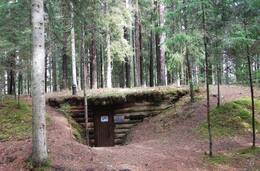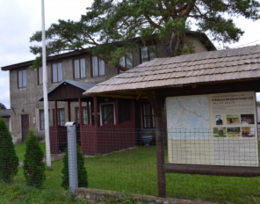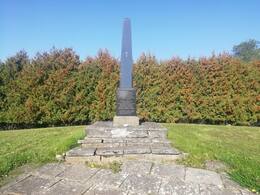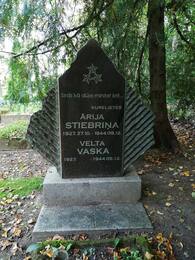The place of the Zlēki tragedy in Latvian history is still unclear
During the Second World War, when most of Latvia was already controlled by the Soviet Union and Kurzeme was ruled by Hitler's German viceroys, the so-called Kurelians in Kurzeme started the struggle for the restoration of Latvia's state independence.
The desperate and idealistic military resistance of the battalion of Kureli Lieutenant Roberts Rubeņš against parts of the German 16th Army, SD and SS units lasted from November 14 to December 9, 1944 in Ugāle, Usma, Renda and Zlēki parishes and ended with tragic events on December 9 and 10, 1944 in Zlēki parish, Ventspils district.
During these two days, in the fight against the national and Soviet partisans, the Germans decided to punish the local population who supported them – they drew a circle around Zlēkā on the map and surrounded it. Everyone who was there was killed, and all eight houses in the marked area were burned down. Most of the murdered were refugees from completely different parts of Latvia, many of whom had arrived very recently.
Whether we have not yet sufficiently understood and appreciated the significance of the Zlēki tragedy in the history of Latvia is also discussed in a conversation with physicist Oļģertas Lielaus, a member of the Latvian Academy of Sciences. He led the initiative group of the Latvian Academy of Sciences, established ten years ago, whose task was to preserve for history and national memory the most vivid evidence of the Latvian resistance movement during World War II and its victims.
Lielaus was 14 years and three months old in December 1944 and can still tell about what happened at that time, as well as remember several vivid episodes.
"[The Rubenis Battalion's] infantry went along Abava, but the carters went through Cirkale. There was a road there. I remember Cirkale was full of refugees. The soldiers entered a large building, which no longer exists. They were interested in what weapons the Germans had. Did they have infantry or other weapons? People said that the wounded Lieutenant Rubenis was being carried in a cart.
Near Cirkale there are houses that [the Germans burned down between December 7 and 10, 1944] - "Grauči", next to "Grauči" is "Jaunarāji", where my relatives lived, all of whom were shot. A total of eight houses were burned down. The highest German SS and police official in Ostland, Jekeln, allegedly drew an even larger circle on the map, including Cirkale, where the punishment was to be carried out, but this was protested.
"The greatest injustice is that around 160 people were shot here. Mostly everyone talks about the heroism of the soldiers, but how can they connect it with the tragedy? Even the Academy of Sciences established a special commission to preserve the evidence of the Zlēki tragedy for history, but this case has been languishing and so far it has not been possible to seriously move it forward."
Wartime oddities and curiosities
When asked if this was not the biggest battle, where Latvians clashed very seriously with Germans, Lielauss points out that there were not a single German in places. "Near Abriņas, across the Abava, they were cursing in Russian, because there were Vlasovites there, but on this side there were Latgalians. At that time, it was fashionable for the bravest men to shoot with the Russian heavy machine gun "Maxim" from the shoulder. And one of them, a Latgalian, cursed in Russian while shooting, and curses in Russian were also heard from the other bank."
"My godmother lived in Cirkale with her husband, a forester. I stayed with them in the summer. A German "Jagdverband" unit, which was under the SD, was stationed in Cirkale. There were about 40 to 50 people in it, but there were practically no Germans among them, but there were Hungarians, Tatars, Latvians. The Germans commanded them. This unit took care of the "Red Arrow" [Soviet partisans]. I remember an episode when they were driving moths into a large cauldron in one of the barns, because the soldiers got drunk before going into the forest, and it was like that on both sides.
Another episode - in Cirkale, where there was a German unit, two Latvian soldiers were captured and locked in a large barn. They were also guarded by Latvians. I remember one of them saying: "Janson, go tell the Frits that one of them blew up". The guards found that the window bars had been moved and one of the detainees, a burglar, had escaped, but the other detainee had a leave certificate, which was considered a safe document, and although he could have fled, he did not.
The head of the guard, an Unterscharführer, an Austrian, who was a handsome guy and very popular with the daughters, arrived. He came out and in the confusion, in the presence of the civilian refugees, shot the detainee with a leave certificate who had not escaped. The confusion was even greater, the shooter was confused, because the accident was on his guard shift, everyone present was confused. The Germans immediately took the shot man away...
Another episode in Cirkale - my father had tuned up the radio so he could listen to English news. Once he was listening to it in a room and a German commander came in behind him. My father thought it would be a big mess, but no, the German comforted him and asked where the front was now in the West. He had family somewhere in Germany, and he was interested in whether the English, French or Americans had entered there.
The situation was such that even the Germans didn't know what was happening in their homes. That was the case in Cirkale at the time.
Zlēki Tragedy Memorial
"During the Russian era, it was accepted: every republic had to have a high-rise building, we have the Academy of Sciences, and it was accepted: every republic, as a rule, needs German emergency works. In Belarus, Ukraine, you can have as many as you want, but we didn't have them, only in Audriņi."
Until recently, we at the Academy of Sciences considered that the greatest war crime committed in Latvia was committed in Zlēka, which has been forgotten until now. The Zlēka tragedy was investigated during the Soviet era by academician Vilis Samsons, who himself had fought in the Soviet partisans.
During the final stages of the war, many residents of Zlēki parish provided assistance to Soviet partisans and intelligence officers, and supported deserters from the German fascist army. Enraged by the failure in the fight against the partisans, the punitive expedition led by General Friedrich Jekeln took brutal revenge on the local population.
But the Soviet partisans had not angered Jekelna - the "Red Arrow" sat in the bushes near Zlēka and watched what was happening. Jekelna had been angered by the Kurelis' struggle and the Rubenis' military resistance, and about 160 innocent people, both big and small, both locals and refugees, who had stayed in the military area for a good week, paid for it with their lives."
Today, there is a Gallows Hill in Zlēka. Some of the murdered are reburied there. About twenty boulders with the names of the murdered people form a circle, and in the center is a black marble obelisk about three meters high. It is supposedly taken from the old "Jewish cemetery" in the Maskavas forshtāde of Riga.
"Wouldn't it be time to return it and instead install a Latvian boulder with today's inscription and the sign of the cross? I think that the victims of the Zlēka tragedy should be shown proper honor, and the place to pay this honor would symbolically be the Gallows Hill in Zlēka. 160 people were destroyed for the Kurelians' fight for the restoration of Latvia's independence, and these fighters were no use to either the German or Soviet occupation power."
Delfi (2014.11.12.) 70 years have passed since the Zlēki tragedy; its place in Latvian history is still unclear . Available: https://bit.ly/3sj6Sdp
Related timeline
Related objects
Rubenis' battalion bunker and battlefields
The restored dugout of the 2nd Company of the Rubenis Battalion is located in a forest by lake Ilziķi in the Usma parish. The dugout can be viewed from the outside for free at any time. However, tours inside the dugout must be booked in advance.
The Battalion of Lieutenant Robert Rubenis was part of a military unit formed by General Jānis Kurelis, and it is known for not surrendering to the German troops and showing heavy resistance. From November 14 to December 9 in 1944 fierce battles were fought in Ugāle, Usma, Renda and Zlēkas parishes between forces of the 16th German Army, SD and SS units under the command of the Police General Friedrich Jeckeln, and the battalion of the Kurelian unit commanded by Lieutenant Roberts Rubenis. The men under Rubenis’ command were well armed and organized and did not associate themselves with any of the two hostile occupying powers. Their actions are considered to be the most wide-spread and longest in the history of the Latvian national resistance movement. In battles near Renda and Zlēkas about 250 German soldiers fell, while only 50 casualties were suffered by Rubenis’ men. The events of those days are represented by the restored dugout in the forest (sod-covered, log cabin dug in the ground) where the men of the Rubenis Battalion once stayed.
Rubenis' battalion museum
Rubenis’ Battalion Museum is located in Ugāle. It is dedicated to the Battalion of R. Rubenis, who served and fought under General J. Kurelis in Kurzeme in 1944, the activities of the Kurelians and the national resistance movement. Museum has an exhibit on the activities of the Latvian Central Council (LCC) and its Ventspils group, as well as the LCC Memorandum with 188 signatures and photographs of signatories that is included in the Latvian National Register of the UNESCO Memory of the World Programme. The LCC was a joint centre of Latvia's highest political leadership with an underground government that operated during the occupation of Latvia from 1943 to 1994. It was formed with the aim of coordinating the activities of various Latvian resistance movements in order to restore Latvia's national independence. The museum also offers a trip to places significant to the history of the battalion (settlement with a reconstructed bunker in the Usma parish, battlefields in Renda and Zlēkas parishes, etc.).
Zlēku Tragedy Memorial Site
The memorial is located near the Zlēki Manor ensemble, in the western part of Karātavkalns. Around twenty boulders with the names of the people killed form a circle, and in the centre is a black marble obelisk about three metres high.
Some of those killed have been reburied at the Zlēki memorial.
In December 1944, in the vicinity of Zlēki, the German Nazi army carried out a large-scale operation against the civilian population.In the combat action log of Army Group Nord, an entry was made at 17.30 on 9 December 1944 that 161 people belonging to the "Rubens Brigade and units of the Red Arrow" had been killed on the enemy side during the action. In Soviet times, this figure was apparently taken as the total number of victims of the Zlēki tragedy, referring to civilians killed.
The course of the action is partly documented in the report of the head of the counter-intelligence section of the German 16th Army of 31 December 1944. It explains that from 5 to 9 December, under the leadership of the highest SS and police leader in Ostland, SS Oberruppenführer and Police General Friedrich Jekeln, a large-scale operation took place at Eichensumpf ("Oak Swamp") against the "Red Arrows" and the remnants of General Kurel's group at Abava.
Monument to the Rubenis Battalion Medics
Monument at the Cirkale cemetery to the priests Ārija Stiebriņa and Velta Vaska, who were shot by the Germans on November 9, 1944. Created by sculptor J. Karlovs.
The two women were shot by units of the German Nazi army on December 9, 1944, along with other captured residents of the Zlēki area, deserters from the German army, or the like.
According to the stories, the young women joined the Rubenis battalion voluntarily. They traveled with the Rubenis battalion from Suntaži to Usma. However, during Jekeln's "Eichensumpf" operation, the young women were arrested on the road, taken to the Vēlogi forester's house for interrogation and shot together with a small group of other detainees. A woman, a resident of Cirkale, knew Ārija and managed to rebury the remains of both girls at the edge of the Cirkale cemetery and maintained this cemetery throughout the Soviet occupation.
Under the leadership of the Supreme SS and Police Leader in Ostland, SS Obergruppenführer and Police General Friedrich Jeckeln, a large-scale operation, Eichensumpf ("Oak Swamp"), took place from December 5 to 9, which was directed against the Red Arrow fighters and General Kurel's group near Abava.
The course of the campaign is partially documented in a report dated December 31, 1944.









